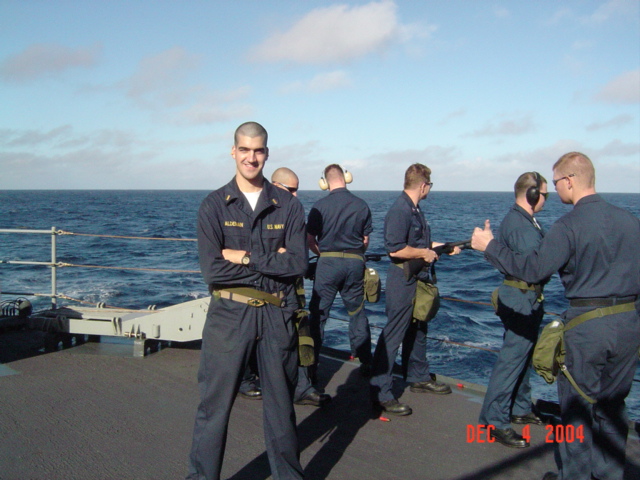Before he was old enough to drive in Iowa, Matt Aldeman built a plywood boat in his parents’ garage. He built a wooden boat trailer and often used the family’s lawn tractor to pull the boat to a nearby lake. After getting his driver’s license, he went out and bought a small sailboat without his parents’ permission.
“I have always loved the feeling of freedom that comes with being on a body of water,” Aldeman said. “It’s just you, the boat, the wind, and the waves.”
His second life-long obsession has been mechanical systems, engines, motors, and all types of energy systems. He also believes strongly in service to others and wanted to pull his weight in society by serving his country in the military. Joining the Navy gave him an opportunity to combine his love of being on a ship, working with mechanical systems, and giving back by serving his country.
The Navy provided a “stepping stone” for his career. As a college junior he interviewed in Washington, D.C. for the Nuclear Propulsion Officer Candidate Program. After he was accepted into the program, the Navy paid him while he completed his Mechanical Engineering degree at Northwestern University in Evanston. Four weeks after his college graduation, he reported to Officer Candidate School in Pensacola, Florida.
“Watching the sun rise or set on the horizon in the middle of the ocean is a sight to behold, and clear starry nights are equally impressive” is how Aldeman describes the view from the bridge of a Navy ship.
During his first two years as a naval officer, Aldeman was the Gunnery Officer on a destroyer homeported near Jacksonville, Florida. He was responsible for all the fire control radars on the ship and all the weapons except the missiles. His favorite part was driving the ship on the bridge. During his Mediterranean deployment, he spent eight hours every day on the bridge. Aldeman says he was continually impressed by the fact that some of the most sophisticated and expensive equipment in the country is operated by young adults 18–30 years old.
“It’s an awesome responsibility,” he says.
After two years, he reported to a year-long nuclear power training school in Charleston, South Carolina. After nuclear power training, he spent his last two years in the Navy working on the nuclear propulsion plant of an aircraft carrier homeported near Seattle. His duties on the aircraft carrier were to oversee the electrical generation in one of the two reactor plants and to operate the reactor in shifts as the propulsion plant watch officer.
The work was often monotonous, and at times he went weeks without seeing sunlight. But he feels that it was a great experience for later in his career. During his deployment to the Persian Gulf, he also took advantage of long-distance education benefits offered by the Navy to pursue his master’s degree from Old Dominion University.
When Aldeman left the Navy, he knew he wanted a career in electrical generation, but decided to switch to the renewable energy field. As all electrical power generation principles are similar in nature, the Navy provided a firm knowledge base. Building on his Navy experience, he was hired by General Electric as a wind farm site manager in Illinois. Operating the wind farm gave him personal satisfaction because he knew that the wind turbines under his care and supervision were putting clean, renewable energy onto the electric grid.
In 2009, Aldeman came to Illinois State to work with Dave Kennell, Randy Winter, and Dave Loomis at the Illinois State University Center for Renewable Energy. During this time he was given the opportunity to teach a course in the then-brand-new renewable energy major. He quickly became hooked. He found that he loved working at the university, discovering new ideas, and working with students. This led him to pursue his Ph.D. in mechanical and aerospace engineering from the Illinois Institute of Technology.
He loves teaching and working with students because they have big ideas, lofty ideals, and lots of energy.
“Our students are going to shape the world for years to come, and I feel privileged to help them gain the knowledge and experiences that will assist them to make the best decisions to benefit society in the future,” he said.
Aldeman is grateful for the opportunities given to him by his Navy career, especially the Post-9/11 GI Bill education benefits. He also applauds universities like Old Dominion University and Illinois State University that grant some college credit for various military training programs. Aldeman says the military is exceptionally good at training its personnel, generally speaking. However, it can be difficult for the civilian sector to connect military training and skills to their civilian equivalencies due to differences in terminology and lack of familiarity with military training programs.

